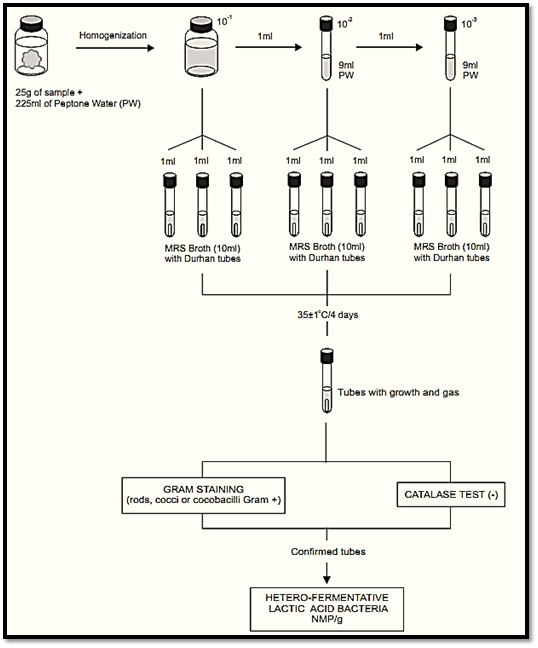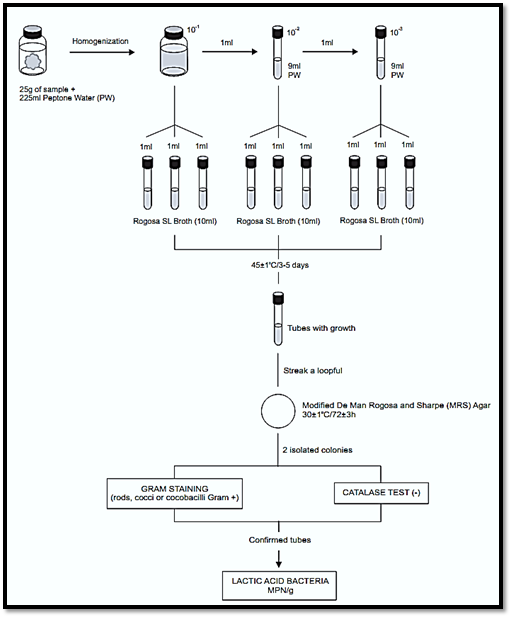


 النبات
النبات
 الحيوان
الحيوان
 الأحياء المجهرية
الأحياء المجهرية
 علم الأمراض
علم الأمراض
 التقانة الإحيائية
التقانة الإحيائية
 التقنية الحيوية المكروبية
التقنية الحيوية المكروبية
 التقنية الحياتية النانوية
التقنية الحياتية النانوية
 علم الأجنة
علم الأجنة
 الأحياء الجزيئي
الأحياء الجزيئي
 علم وظائف الأعضاء
علم وظائف الأعضاء
 الغدد
الغدد
 المضادات الحيوية
المضادات الحيوية| Most probable number ( MPN) methods APHA 2001 for lactic acid bacteria in foods |
|
|
|
Read More
Date: 13-3-2016
Date: 7-3-2016
Date: 3-3-2016
|
Most probable number ( MPN) methods APHA 2001 for lactic acid bacteria in foods
Method of the American Public Health Association (APHA), as described in the 4th Edition of the Compendium of Methods for the Microbiological Examination of Foods (Hall et al., 2001). There are two recommended procedures, one using MRS Broth, for heterofermentative lactic acid bacteria, and the other using Rogosa SL Broth, for total lactic acid bacteria. The procedure described below does not present these details, as they are supposed to be known to the analyst.
1- Material required for analysis
Preparation of the sample and serial dilutions
• Diluent: 0.1% Peptone Water (PW)
• Dilution tubes containing 9 ml 0.1% Peptone
Water (PW)
Count using MRS Broth
• De Man Rogosa & Sharpe (MRS) Broth
• Laboratory incubator set to 35 ± 1°C
Count using Rogosa SL Broth
• Rogosa SL Broth
• De Man Rogosa & Sharpe (MRS) Agar Modified
• Anaerobic gas-generating kit
• Laboratory incubator set to 45 ± 1°C
• Laboratory incubator set to 30 ± 1°C
Confirmation
• Gram Stain Reagents
• 3% Hydrogen Peroxide (for catalase test)
2 - Procedure using the MRS broth
A general flowchart for the enumeration of heterofermentative lactic acid bacteria in foods using the Most Probable Number (MPN) method APHA 2001 with MRS Broth is shown in Figure 1.
a) Preparation of the sample and serial dilutions.
However, Butterfield’s Phosphate Buffer should not be used to prepare the samples, since it may cause injuries to the cells. The recommended diluent is 0.1% Peptone Water (PW).
b) Inoculation and incubation. Select three adequate dilutions of the sample and inoculate a series of three tubes with MRS broth per dilution, add-ing 1 ml of the dilution per tube containing 10 ml MRS and Durham tubes. Incubate the tubes at 35 ± 1ºC/4 days.
c) Confirmation. Verify the tubes exhibiting growth and gas production, both of which are features indicative of heterofermentative lactic acid bacteria, and subject these tubes to Gram staining and catalase test. The Gram-positive (cocci or rods) catalase-negative cultures are considered confirmed.
d) Calculating the results. Record the number of confirmed tubes and determine the MPN/g or ml .
3 - Procedure using the Rogosa SL Broth
A general flowchart for the lactic acid bacteria enumeration by the MPN method APHA 2001 using Rogosa SL Broth is shown in Figure 2.
a) Preparation of the sample and serial dilutions.
However, Butterfield’s Phosphate Buffer should not be used to prepare the samples, since it may cause injuries to the cells. The recommended diluent is 0.1% Peptone Water.
b) Inoculation and incubation. Select three adequate dilutions of the sample and inoculate a series of three tubes with Rogosa SL Broth per dilution, adding 1 ml of the dilution per tube containing 10 ml Rogosa SL. Incubate the tubes for three to five days at 45 ± 1ºC. The Rogosa SL broth may be substituted by reconstituted Milk Powder at a concentration of 10%, supplemented with 0.05% glucose. In this case, the tubes must be incubated for three to five days at 30 ± 1ºC.

Figure 1 Scheme of analysis for the enumeration of heterofermentative lactic acid bacteria in foods using the Most Probable Number (MPN) method APHA 2001 with MRS Broth (Hall et al., 2001).
c) Plating. Of each tube exhibiting growth, streak a loopful of the culture onto plates containing Modified MRS Agar and incubate the plates at 30 ± 1ºC/72 ± 3 h.
d) Confirmation. Select two colonies isolated from each plate and subject to Gram staining and catalase test. The Gram-positive (cocci or rods) and catalase-negative cultures are considered confirmed as lactic acid bacteria.
e) Calculating the results. Record the number of confirmed tubes and determine the MPN/g or ml.

Figure 2 Scheme of analysis for the enumeration of lactic acid bacteria in foods using the Most Probable Number (MPN) method APHA 2001 with Rogosa SL Broth (Hall et al., 2001)
References
Silva, N.D .; Taniwaki, M.H. ; Junqueira, V.C.A.; Silveira, N.F.A. , Nasdcimento , M.D.D. and Gomes ,R.A.R .(2013) . Microbiological examination methods of food and water a laboratory Manual. Institute of Food Technology – ITAL, Campinas, SP, Brazil .
Hall, P.A., Ledenbach, L. & Flowers, R.S. (2001) Acid-producing microorganisms. In: Downes, F.P. & Ito, K. (eds). Compendium of Methods for the Microbiological Examination of Foods. 4th edition. Washington, American Public Health Association. Chapter 19, pp. 201–207.



|
|
|
|
لشعر لامع وكثيف وصحي.. وصفة تكشف "سرا آسيويا" قديما
|
|
|
|
|
|
|
كيفية الحفاظ على فرامل السيارة لضمان الأمان المثالي
|
|
|
|
|
|
|
مؤسسة الوافي تبيّن آلية عملها التوثيقي لتاريخ العراق الحديث
|
|
|